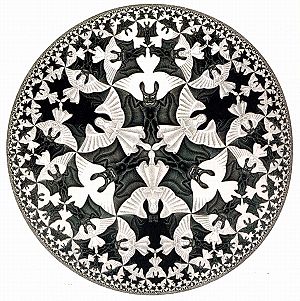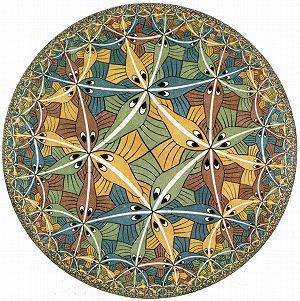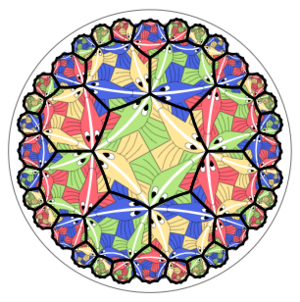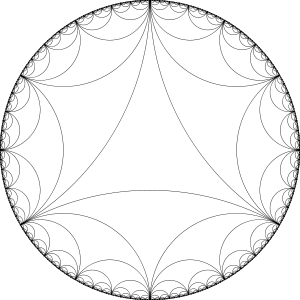Hyperbolic Geometry

Explorations
You may begin exploring hyperbolic geometry with the following explorations. We recommend doing some or all of the basic explorations before reading the section. Gaining some intuition about the nature of hyperbolic space before reading this section will be more effective in the long run.
Basic Explorations
- Hyperbolic Paper Exploration
- Escher's Circle Limit Exploration This exploration is designed to help the student gain an intuitive understanding of what hyperbolic geometry may look like. Escher's prints are nice examples that illustrate what we would see when looking down on a hyperbolic universe.
- Hyperbolic Geometry Exploration NonEuclid allows us to draw acurate pictures of objects in hyperbolic space.
Further explorations that help give a better understanding of hyperbolic geometry.
- Hyperbolic Geometry II with NonEuclid Exploration
- Hyperbolic Tessellations Exploration
- Ideal Hyperbolic Tessellations Exploration
- Hyperbolic Escher Exploration
Hyperbolic Space
We have seen two different geometries so far: Euclidean and spherical geometry. Geometry is meant to describe the world around us, and the geometry then depends on some fundamental properties of the world we are describing. Objects that live in a flat world are described by Euclidean (or flat) geometry, while objects that live on a spherical world will need to be described by spherical geometry.

In two dimensions there is a third geometry. This geometry is called hyperbolic geometry. If Euclidean geometry describes objects in a flat world or a plane, and spherical geometry describes objects on the sphere, what world does hyperbolic geometry describe? Like spherical geometry, which takes place on a sphere, hyperbolic geometry takes place on a curved two dimensional surface called hyperbolic space.
We will describe hyperbolic space in several different ways. In Escher's work, hyperbolic space is a distorted disk. All of the angels in Circle Limit IV (Heaven and Hell) live in hyperbolic space, where they are actually the same size, as do the devil figures. The image that Escher presents is a distorted map of the hyperbolic world.
You can explore Escher's hyperbolic Circle Limit prints and get an introduction to hyperbolic geometry in the Escher's Circle Limit Exploration
Models of Hyperbolic Space
On a sphere, a small neighborhood of a point looks like a cap. In hyperbolic space, every point looks like a saddle:
| A piece of a sphere | A piece of hyperbolic space |
|---|---|
 |

|
Unfortunately, while you can piece caps together to make a sphere, piecing saddles together quickly runs out of space. Try this yourself with the Hyperbolic Paper Exploration.

Hyperbolic paper is a floppy, saddle like object. Eventually, it contains too many triangles in too small a space to continue any further, although most people and run out of patience before running out of room. It's also possible to crochet models of hyperbolic space.
Because globes are unwieldy, navigators use flat maps of the spherical earth. Maps of the Earth are necessarily distorted, for example Greenland appears extremely large on the common Mercator map of the Earth, shown with red dots to indicate the distortion of area.
Poincare Disk Model
Because models of hyperbolic space are unwieldy (not to mention infinite), we will do all of our work with a map of hyperbolic space called the Poincaré disk. The Poincaré disk is the inside of a circle (although the circle is not included) and is badly distorted near its edge.
Objects near the edge of the Poincaré disk are larger than they appear.
| Hyperbolic man takes a walk |
|---|
 |
The picture shows a stick man as he walks towards the edge of the disk. He appears to shrink, as does the distance he moves with each step. But this disk is a distorted map, and in the actual hyperbolic space his steps are all the same length and he stays the same size. The man will never reach the edge of the disk, because it is infinitely far away. The edge is drawn dashed because it is not actually part of hyperbolic space.
The geodesics in hyperbolic space play the role of straight lines. Geodesics appear straight to an inhabitant of hyperbolic space, and they are the shortest paths between points. In the Poincaré disk model, geodesics appear curved. They are arcs of circles. Specifically:
Geodesics are arcs of circles which meet the edge of the disk at 90°.
Geodesics which pass through the center of the disk appear straight.
| Some geodesics in the Poincaré disk |
|---|

|
Practice drawing geodesics in the Poincaré disk with Hyperbolic Geometry Exploration.
Upper Half Space Model

Another commonly used model for hyperbolic space in the upper half space model. In this model, hyperbolic space is mapped to the upper half of the plane. The model includes all points (x,y) where y>0. In other words, everything above the x-axis.
The geodesics in the upper half space model are lines perpendicular to the x-axis and semi-circles perpendicular to the x-axis. The image of the mosaic to the right shows three geodesics. The lighter semi-circles at the bottom create 2 geodesics, and the dark semi-circle in the background creates the third geodesic. Geodesics measure shortest distance and play the role of straight lines in Euclidean geometry, hence these three geodesics form an (ideal) triangle. Note how the geometric figures have rather small angle measures just as in the Poincaré disk model discussed above.
Non-Euclid also allows the user to experiment with this model of hyperbolic space.
Other Models
There are several other models that can be used to represent hyperbolic space. The Pseudosphere is a model that accurately shows how hyperbolic space curves, but only models a portion of the whole space.
The Beltrami-Klein model represents hyperbolic space as the interior of a disk, just as the Poincare disk model, but it chooses to distort angles rather than geodesics. So the geodesics actually appear as straight lines, but the angles between them are no longer correctly shown.
Plenty of other models exist, just like there are many ways to make maps of the spherical geometry of the Earth, but the Poincare disk model is the one that Escher uses exclusively.
Polygons and Defect
- Polygon
- A polygon in hyperbolic geometry is a sequence of points and geodesic segments joining those points. The geodesic segments are called the sides of the polygon.
A triangle in hyperbolic geometry is a polygon with three sides, a quadrilateral is a polygon with four sides, and so on, as in Euclidean geometry. Here are some triangles in hyperbolic space:
From these pictures, you can see that:
The sum of the angles in any hyperbolic triangle is less than 180°.
- Defect
- The defect of a hyperbolic triangle is 180° – (angle sum of the triangle).
By cutting other polygons into triangles, we see that a hyperbolic polygon has angle sum less than that of the corresponding Euclidean polygon.
Define the defect for a hyperbolic polygon with sides to be .
Putting this together with the defect in spherical geometry:
The defect of a polygon is the difference between its angle sum and the angle sum for a Euclidean polygon with the same number of sides.
This statement works in spherical and hyperbolic geometry, for polygons with any number of sides. It even works for biangles, because a biangle in Euclidean geometry must have two 0° angles. The area of a hyperbolic polygon is still proportional to its defect:
Area of a hyperbolic polygon = .
This equality is a special case of the Gauss-Bonnet theorem.
In spherical geometry, we had a formula relating the defect of a polygon to the fraction of the sphere's area covered by the polygon. For a sphere of radius 1, the total surface area of the sphere is , and so the area of a polygon is which (after a little simplification) is exactly the same formula as in hyperbolic space!
Ideal Polygons
- Ideal Triangle
- An ideal triangle consists of three geodesics that touch at the boundary of the Poincaré disk.
The three geodesics are called the sides of the ideal triangle. Since the boundary of the disk isn’t part of hyperbolic space, the sides of an ideal triangle are infintely long and never actually meet. However, the do get closer together as they head towards the edge. The three points on the boundary are called the ideal vertices of the ideal triangle, and play a similar role as the vertices of an ordinary triangle. Since the sides are all perpendicular to the Poincaré disk boundary, they make an angle of 0° with each other.
You can create other ideal polygons in a similar manner:

| Ideal triangles and an ideal hexagon |
The area formula implies that any ideal triangle has area , because the angle sum is zero and its defect is 180°. Both ideal triangles shown above have the same area even though the distortion of the Poincaré disk makes one look much smaller than the other. The ideal hexagon shown has angle sum zero, so it’s defect is 720° and its area is .
Hyperbolic Tessellations
Hyperbolic Tessellations Exploration
A hyperbolic tessellation is a covering of hyperbolic space by tiles, with no overlapping tiles and no gaps. Escher’s Circle Limit prints are examples of hyperbolic tessellations. Like his other tessellations, Escher began with a geometric tessellation by polygons and worked from there.
Consider Escher’s Circle Limit I, shown with geometric scaffolding consisting of geodesics drawn in red:
The spines of the fish, emphasized with red lines, form a tessellation of hyperbolic space by quadrilaterals. Since these quadrilaterals meet four or six at a vertex, they have corner angles 90°-60°-90°-60°. They are not regular polygons because regular polygons have all sides and all angles equal.
There are plenty of other tessellations of hyperbolic space, including regular tessellations. In fact, there are infinitely many regular tessellations of hyperbolic space. This stands in sharp contrast to Euclidean space, which has only three, and to spherical geometry, where there are only five non-degenerate possibilities (corresponding to the Platonic solids). Hyperbolic space is easy to tessellate because the corner angles of polygons want to be small, and small angles fit nicely around a vertex.
As in the other two geometries, we describe regular tessellations by the number of sides in each polygon and the number of polygons that meet at a vertex.
- Schläfli Symbol
- The Schläfli symbol describes the regular tessellation by -gons where meet at each vertex.
Examples

This tessellation has seven triangles at each vertex, and so its Schläfli symbol is {3,7}.
The triangles have
360°/7 ≈51.4°
angles and angle sums of approximately
3×51.4°=154.3°
This gives a defect of approximately 180°–154.3° = 25.7° and an area of approximately 0.45.

This tessellation has four pentagons at each vertex, and so its Schläfli symbol is {5,4}.
Each pentagon has five 90° angles.
The angle sum for each pentagon is 450°.
Since Euclidean pentagons have angle sum 540°, these pentagons have a defect of 540°-450° = 90° and an area of .

This tessellation has six quadrilaterals at each vertex, and so its Schläfli symbol is {4,6}.
Each quadrilateral has four 60° angles.
The angle sum for each quadrilateral is 240°.
Since Euclidean quadrilaterals have angle sum 360°, these quadrilaterals have a defect of 360°-240° = 120° and an area of .
Escher's Circle Limit III

Escher's Circle Limit III is his most accomplished print based on hyperbolic space. It is also his most subtle.
Looking at the white spines of the fish, it appears to be a tessellation of hyperbolic space by triangles and squares, with three triangles and three squares coming together at each vertex. This would mean that the corner angles of both polygons are 60° each, but this gives the triangle an angle sum of 180°, which cannot happen in hyperbolic space!
However, Circle Limit III clearly has the flavor of a hyperbolic tessellation. H.S.M Coxeter, a mathematician and friend of Escher’s analyzed the print[1], and discovered that the white circular arcs along the spines meet the boundary of the disk at 80° each, rather than the 90° required to be geodesic. Since the white lines are not geodesics, neither the “triangle” or the “square” is really a polygon at all! Even Escher does not seem to have realized this, although most probably he would not have cared, as he was very satisfied with the print and the suggestion of infinity it presents.
A natural underlying tessellation for Circle Limit III is the {8,3} tessellation by octagons:


The image on the right shows a hyperbolic geodesic that runs through the midpoints of the sides of the octagons, surrounded by two curves (not geodesics) at a fixed distance from the geodesic. The rightmost of these curves forms the spines of one row of fish in Circle Limit III.
Ideal Tessellations

Drawing hyperbolic tessellations by hand is quite difficult. However, tessellations by ideal polygons are somewhat easier to work with. The advantage of an ideal tessellation is that all the vertices lie on the boundary (or, more precisely, approach the boundary) of the Poincaré disk. Since the tiles in ideal tessellations are not polygons, but ideal polygons, they do not have Schläfli symbols. However, they do fit into the scheme of regular tessellations, with the odd feature that infinitely many tiles now meet at an ideal vertex.
Learn more about these in the Ideal Hyperbolic Tessellations Exploration.
Exercises
Relevant examples from Escher's work
Related Sites
- NonEuclid: A java applet for working with the Poincaré disk, by Joel Castellanos.
- Hyperbolic Geometry Applet: by Paul Garrett
- Circull: An iPad/iPhone app to play a game with hyperbolic tessellations, by Anthony Thibault.
- Online Exhibit: Hyperbolic Space by The Institute For Figuring.
- CurvedSpaces A non-Euclidean space flight simulator by Jeff Weeks.
- Doug Dunham has a collection of articles on hyperbolic tessellations and Escher's Circle Limit series.
- Hyperbolic Tessellations, by David Joyce.
- Hyperbolic Tessellations Applet by Don Hatch.
- Capturing Infinity, the Circle Limit Series of M.C. Escher, by T. Wieting, Reed Magazine 2010.












